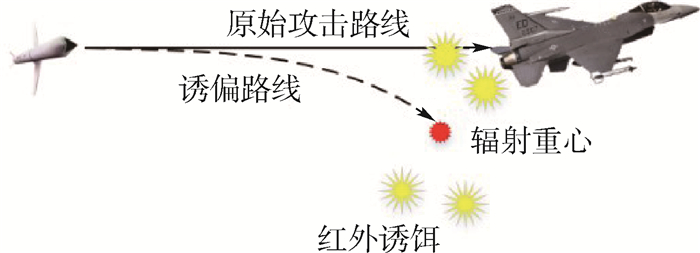-
摘要:
为了摸清红外空空导弹性能、提高导弹作战效能,需要全面有效地对导弹抗干扰能力进行评估。但是受限于无穷多的对抗情况,目前多数基于典型对抗场景进行研究分析,不够全面。为此使用改进的拉丁超立方采样法在全范围内设计采样点。首先,对红外对抗原理和仿真系统进行说明和构建,确定输入参数范围和类型;其次,对拉丁超立方采样进行改进优化,并将其生成的采样结果按需离散化,满足诱饵离散型参数设置需求;最后,运用上述生成的初始参数组合运行仿真系统,将获取的数据作为样本集交给随机森林模型学习,通过调优参数及调整损失矩阵后,得到预测精度为90.4%的红外空空导弹抗干扰效能评估模型。通过仿真,验证了所提模型在不同红外对抗态势和不同提取误差下的有效性。
Abstract:In order to estimate the performance of infrared air-to-air missiles and improve its combat effectiveness, an overall valid evaluation of missiles' anti-jamming capability is required. However, due to the infinite number of countermeasure situations, most scholars currently study and analyze them based on typical countermeasure scenarios, which is inadequate. For this reason, the improved Latin hypercube sampling method was used to design sampling points in the whole range. Firstly, the infrared countermeasure principle and simulation system were explained and constructed, and the range and the type of input parameters were determined. Secondly, the Latin hypercube sampling method was improved and optimized, and the generated sampling results were discretized as needed to meet the needs of the decoy discrete parameter setting. Finally, the initial parameter combinations generated above were used to run the simulation system, and the obtained data were given to the random forest model as learning sample sets. After tuning the parameters and adjusting the loss matrix, the anti-jamming effectiveness evaluation model of the infrared air-to-air missiles was obtained and the prediction accuracy was 90.4%. Through simulation, the effectiveness of the model was verified under different IR countermeasures and different measurement errors..
-
表 1 图像特征定义
Table 1. Image feature definition
特征编号 特征 定义 c1 能量 
c2 能量变化率 
c3 平均灰度 c3=c1/s c4 长宽比 c4=l/w 注:m1×n1为导引头图像像素数;Ei, j为像素点能量;s为目标图像区域像素点个数;l和w分别为目标图像区域外接矩形的长和宽。 表 2 性能对比结果
Table 2. Performance comparison results
方法 规模m×n 平均值Maximin 平均值Φp 计算时间/s lhs 50 000×12 0.189 6.328 44.28 TPLHD 50 000×12 0.323 5.559 46.32 表 3 随机森林模型结果
Table 3. Random forest model results
预测模型 模型1 模型2 P1 P2 P3 P1 P2 P3 T1 35 505 114 110 32 336 604 2 789 T2 953 4 364 130 403 4 533 511 T3 1 915 375 6 534 324 164 8 336 Accuracy/% 92.8 92.8 90.4 90.4 90.4 90.4 PPV or FDR of T1/% 93 2 2 98 11 24 PPV or FDR of T2/% 2 90 2 1 86 4 PPV or FDR of T3/% 5 8 96 1 3 72 PPV/% 93 90 96 98 86 72 FDR/% 7 10 4 2 1 28 注:PPV or FDR of T1为实际情况第一级的PPV或者FDR。 表 4 对抗场景设置
Table 4. Countermeasure scenario setting
参数 场景a 场景b 场景c 目标机动类型 Ⅰ Ⅱ Ⅲ 首枚诱饵发射时间/s 1 1 1.5 诱饵总数 12 24 48 每组数量 12 4 6 组间间隔/s 0.6 0.8 1 组内间隔/s 0.1 0.1 0.2 每次投掷数量 2 1 2 水平投掷角/(°) 60 60 30 垂直投掷角/(°) 60 -60 -30 诱饵投掷速度/(m·s-1) 10 30 40 导弹水平进入角/(°) 85 10 160 初始弹目距离/m 2 500 3 500 4 500 预测结果 Level 3 Level 2 Level 1 仿真命中率/% 29 64 96 -
[1] 黄鹤松, 童中翔, 李建勋, 等. 基于空战评估的红外空空导弹功能仿真[J]. 红外与激光工程, 2015, 44(3): 803-809. doi: 10.3969/j.issn.1007-2276.2015.03.003HUANG H S, TONG Z X, LI J X, et al. Functional simulation of infrared air-to-air missiles based on combat assessment[J]. Infrared and Laser Engineering, 2015, 44(3): 803-809(in Chinese). doi: 10.3969/j.issn.1007-2276.2015.03.003 [2] 牛得清, 伍友利, 徐洋, 等. 点源红外诱饵干扰下环境复杂度量化建模[J]. 红外与激光工程, 2020, 49(2): 211-219. https://www.cnki.com.cn/Article/CJFDTOTAL-HWYJ202002028.htmNIU D Q, WU Y L, XU Y, et al. Quantification modeling for environmental complexity under point source infrared decoy interference[J]. Infrared and Laser Engineering, 2020, 49(2): 211-219(in Chinese). https://www.cnki.com.cn/Article/CJFDTOTAL-HWYJ202002028.htm [3] 李慎波, 李韬锐, 童中翔, 等. 导弹战术参数对面源红外诱饵干扰效能影响[J]. 红外与激光工程, 2018, 47(7): 133-142. https://www.cnki.com.cn/Article/CJFDTOTAL-HWYJ201807019.htmLI S B, LI T R, TONG Z X, et al. Influence of tactical parameters of missile on jamming effectiveness of surface source infrared decoy[J]. Infrared and Laser Engineering, 2018, 47(7): 133-142(in Chinese). https://www.cnki.com.cn/Article/CJFDTOTAL-HWYJ201807019.htm [4] 徐洋, 方洋旺, 伍友利, 等. 红外诱饵干扰下导引头视线角速度跳变特征建模[J]. 红外与激光工程, 2019, 48(5): 110-120. https://www.cnki.com.cn/Article/CJFDTOTAL-HWYJ201905015.htmXU Y, FANG Y W, WU Y L, et al. Los-rate of seeker jump characteristic modelling under IR flare countermeasure[J]. Infrared and Laser Engineering, 2019, 48(5): 110-120(in Chinese). https://www.cnki.com.cn/Article/CJFDTOTAL-HWYJ201905015.htm [5] 唐善军, 王枫, 陈晓东. 红外导弹抗干扰能力指标体系和评估研究[J]. 上海航天, 2017, 34(4): 144-149. https://www.cnki.com.cn/Article/CJFDTOTAL-SHHT201704017.htmTANG S J, WANG F, CHEN X D. Anti-jamming performance index system and evaluation of infrared missile[J]. Aerospace Shanghai, 2017, 34(4): 144-149(in Chinese). https://www.cnki.com.cn/Article/CJFDTOTAL-SHHT201704017.htm [6] DE JONG W, DAM F A M, KUNZ G J, et al. IR seeker simulator and IR scene generation to evaluate IR decoy effectiveness[C]//European Symposium on Optics and Photonics for Defence and Security, 2004, 5615: 100-111. [7] SHEIKHOLESLAMI R, RAZAVI S. Progressive Latin hypercube sampling: An efficient approach for robust sampling-based analysis of environmental models[J]. Environmental Modelling & Software, 2017, 93: 109-126. http://www.onacademic.com/detail/journal_1000039864216710_7baf.html [8] MINASNY B, MCBRATNEY A B. A conditioned Latin hypercube method for sampling in the presence of ancillary information[J]. Computers & Geosciences, 2006, 32(9): 1378-1388. http://www.sciencedirect.com/science?_ob=ShoppingCartURL&_method=add&_eid=1-s2.0-S009830040500292X&originContentFamily=serial&_origin=article&_ts=1483837534&md5=0cfa6bbe96d2aeae4be74f09c998f510 [9] VAN DAM E R, RENNEN G, HUSSLAGE B. Bounds for maximin Latin hypercube designs[J]. Operations Research, 2009, 57(3): 595-608. doi: 10.1287/opre.1080.0604 [10] ZHANG J, XU J, JIA K, et al. Optimal sliced Latin hypercube designs with slices of arbitrary run sizes[J]. Mathematics, 2019, 7(9): 854. doi: 10.3390/math7090854 [11] YUAN R, GUO B, LIU M Q. Flexible sliced Latin hypercube designs with slices of different sizes[J]. Statistical Papers, 2021, 62: 1117-1134. doi: 10.1007/s00362-019-01127-6 [12] WESSING S, LÓPEZ-IBÁÑEZ M. Latin hypercube designs with branching and nested factors for initialization of automatic algorithm configuration[J]. Evolutionary Computation, 2019, 27(1): 129-145. doi: 10.1162/evco_a_00241 [13] ZHAO Z W, YANG J M, HU Z Y, et al. A differential evolution algorithm with self-adaptive strategy and control parameters based on symmetric Latin hypercube design for unconstrained optimization problems[J]. European Journal of Operational Research, 2016, 250(1): 30-45. doi: 10.1016/j.ejor.2015.10.043 [14] ZHOU X J, LIN D K J, HU X L, et al. Sequential Latin hypercube design with both space-filling and projective properties[J]. Quality and Reliability Engineering International, 2019, 35(6): 1941-1951. doi: 10.1002/qre.2485 [15] LONG T, WU D, CHEN X, et al. A deterministic sequential maximin Latin hypercube design method using successive local enumeration for metamodel-based optimization[J]. Engineering Optimization, 2016, 48(6): 1019-1036. doi: 10.1080/0305215X.2015.1081518 [16] 叶鹏程, 潘光, 高山. 一种快速优化拉丁超立方试验设计方法[J]. 西北工业大学学报, 2019, 37(4): 714-723. doi: 10.3969/j.issn.1000-2758.2019.04.010YE P C, PAN G, GAO S. Sampling design method of fast optimal Latin hypercube[J]. Journal of Northwestern Polytechnical University, 2019, 37(4): 714-723(in Chinese). doi: 10.3969/j.issn.1000-2758.2019.04.010 [17] 张鑫, 吴海涛, 曹雪虹. Hadoop环境下基于随机森林的特征选择算法[J]. 计算机技术与发展, 2018, 28(7): 88-92. doi: 10.3969/j.issn.1673-629X.2018.07.019ZHANG X, WU H T, CAO X H. A feature selection algorithm based on random forest in Hadoop platform[J]. Computer Technology and Development, 2018, 28(7): 88-92(in Chinese). doi: 10.3969/j.issn.1673-629X.2018.07.019 [18] 李扬, 祁乐, 聂佩芸. 大规模数据的随机森林算法[J]. 统计与信息论坛, 2020, 35(6): 24-33. doi: 10.3969/j.issn.1007-3116.2020.06.004LI Y, QI L, NIE P Y. A distributed random forest algorithm for massive data[J]. Statistics & Information Forum, 2020, 35(6): 24-33(in Chinese). doi: 10.3969/j.issn.1007-3116.2020.06.004 [19] 兰巍, 贾素玲, 宋世民, 等. 基于随机森林的航天器电信号多分类识别方法[J]. 北京航空航天大学学报, 2017, 43(9): 1773-1778. doi: 10.13700/j.bh.1001-5965.2016.0661LAN W, JIA S L, SONG S M, et al. Multi-classification spacecraft electrical signal identification method based on random forest[J]. Journal of Beijing University of Aeronautics and Astronautics, 2017, 43(9): 1773-1778(in Chinese). doi: 10.13700/j.bh.1001-5965.2016.0661 -







 下载:
下载:










